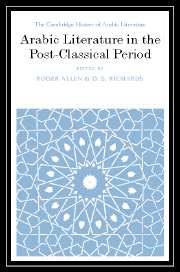Book contents
- Frontmatter
- The post-classical period: parameters and preliminaries
- Part I Elite Poetry
- 1 Arabic poetry in the post-classical age
- 2 Poetic creativity in the sixteenth to eighteenth centuries
- 3 Arabic religious poetry, 1200–1800
- 4 The role of the pre-modern: the generic characteristics of the band
- Part II Elite prose
- Part III Popular poetry
- Part IV Popular prose
- Part V Drama
- Part VI Criticism
- Bibliography
- Index
- References
3 - Arabic religious poetry, 1200–1800
from Part I - Elite Poetry
Published online by Cambridge University Press: 28 March 2008
- Frontmatter
- The post-classical period: parameters and preliminaries
- Part I Elite Poetry
- 1 Arabic poetry in the post-classical age
- 2 Poetic creativity in the sixteenth to eighteenth centuries
- 3 Arabic religious poetry, 1200–1800
- 4 The role of the pre-modern: the generic characteristics of the band
- Part II Elite prose
- Part III Popular poetry
- Part IV Popular prose
- Part V Drama
- Part VI Criticism
- Bibliography
- Index
- References
Summary
By the thirteenth century, Arabic poetry had entered a phase of conservation as scholars and littérateurs sought to protect and preserve their Arab heritage. The recurrent Crusades and, above all, the Mongol advance challenged Arab culture and Muslim supremacy, which were shaken further in 1492 by the Christian reconquest of Spain. These same events, however, contributed to the creative growth in Arab religious poetry that occurred at this time. In particular, the mystical verse of Ibn al-Fāridd. and al-Būsīrī’s hymns to the Prophet Muhammad struck a devotional chord, which continues to resonate within Arabic religious poetry and Muslim culture.
Reference to religion was common in classical and post-classical Arabic poetry. A poet might invoke the Koran and the fast of Ramadan, trace his lineage to a prophet, or compare his beloved’s beauty to that of Joseph. But such features were standard, often clichéd elements of the poetic repertoire, and so alone should not define verse as religious. By contrast, numerous poems directly address concerns involving God, His prophets, and pressing matters of life and death. Many Sunni and Shia Muslims, together with some of their Jewish and Christian contemporaries, composed Arabic verse to place their joys and sorrows within religious contexts that would give them meaning. Not surprisingly, Arabic religious poetry assumes many forms, from the refined verse of professional poets to the vernacular prayers of pilgrims. This verse, then, is not restricted to a particular style or set of themes, though Arabic religious poetry has been closely associated with several specific genres, including zuhdiyya, or ascetic poetry.
- Type
- Chapter
- Information
- Arabic Literature in the Post-Classical Period , pp. 74 - 86Publisher: Cambridge University PressPrint publication year: 2006
References
- 1
- Cited by



